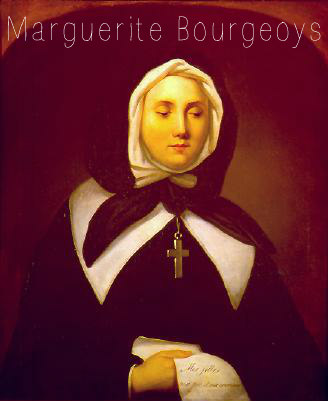
Attributed to Antoine Plamondon – Image and information retrieved from http://www.virtualmuseum.ca/Exhibitions/Gestes/francais/b_ec_msg_mbourgeo.html context image. Photo: Alain Comtois
MONTREAL’S MARGUERITE BOURGEOYS:
LEADER, TEACHER, FOUNDER, HELPER, BELIEVER
I N T R O D U C T I O N:
Though born into a French family, Marguerite Bourgeoys lived an exceptional life that led her across seas to become a woman of great acknowledgment and admiration in Canadian history. Marguerite’s impact on Canada may not be familiar to or be easily understood by all Canadians today. However, her story provides insight on how courageous and devoted women such as herself, contributed to the country that Canada is today. Through opportunity and determination, Marguerite Bourgeoys became an important historical figure whose strong leadership skills, dedication to teaching and helping, and commitment to retaining Christian faith, played an important role in the future of Canadians.
N O T E S:
Marguerite was born on April 17, 1620 in Troyes, France, and went on to live in this French community for thirty-three years.
Written in French within the baptismal register of Saint-Jean-au-Marche church, is a record of Marguerite’s baptism on April 17, 1620. Marguerite was seventh of the known thirteen children of her parents, Abraham Bourgeoys and Guillemette Garnier.
Within her parents’ marriage contract, there is acknowledgement of payment for the bride’s dowry of six hundred livres. This documents suggests that her parents came from artisan class backgrounds, where women worked alongside men in the family business. Though not concluded, this could have been a contributing factor to the work ethic that Marguerite portrays throughout her eighty long-lived years of life.
During a procession, Marguerite found herself moved at the sight of a statue of the Blessed Virgin. Once witnessing this statue of Mary, Marguerite made the life-changing decision to devote herself to the service of God. Following this turning point in her life, Marguerite joined the Congrégation Notre-Dame de Troyes as an extern member where she taught poor children.
Marguerite’s leadership skills were again portrayed when she became the leader of about 400 laywomen who like her, devoted themselves to the service of those affected by poverty.
In 1652 by a combination of chance and association, Marguerite was introduced to Paul de Chomedey de Maisonneuve, a founder of Montreal, who was in France looking for a schoolmistress. While returning to France in search of a teacher to bring back to the Montreal project, De Maisonneuve met Marguerite through the sisters and was recommended as a suitable candidate due to her leadership and teaching abilities that she demonstrated at the congregation.
On June 20th, 1653 just months after Marguerite’s invitation from de Maisonneuve, she made her first attempt to depart for the new colony on the Saint-Nicolas-de-Nantes. Unfortunately, the first departure experienced troubles at sea that forced the ship to return to the port and set sail for its second attempt on July 20th of the same year.
The ship that Marguerite had boarded made a successful arrival in Quebec in 1653.
One of the main reasons that Marguerite made the journey to Canada, was to fulfill her dream of becoming a teacher. Marguerite opened the first schoolroom in Montreal on April 30, 1658.
On October 14, 1658, Marguerite began a 2-month voyage back to France to recruit women to come and join her in New France.
In 1669, Bishop François de Laval gave Marguerite Bourgeoys and her accompanied teachers permission to teach wherever there was need in all of New France. It was in the stable-school that the children of the colony were taught the basics of Christian faith and skills such as counting, reading and writing. Marguerite would also teach young women household skills and prepared them for the duties that would come to them as wives and mothers.
In addition to the schoolroom, Marguerite took it upon her to assist young immigrant women known as Les Filles du Roy, who came for the purpose to be brides of the settlers. Marguerite provided the future brides with a home, where she lived with them and helped them to adapt to the new land.
After Marguerite and her companions received permission to teach from Bishop de Laval, he officially approved the “Institut des Filles séculières de la Congrégation de Notre-Dame” in 1676.
Marguerite lived an exceptional life and truly became one of Canada’s earliest female historic figures in recognition of the impacts she had on those who settled in Montréal.
Marguerite passed away in 1700, but her story of dedication, leadership, and faith continues to be shared, and her mission is still relevant in present day Canada.
The Congrégation de Notre-Dame remains a community of religious women in Montréal, who dedicate their founding to Saint Marguerite Bourgeoys, “the first educator of Montreal and a pioneer of New France.” Following in Marguerite’s footsteps the sisters freely serve people and the Church.
It is without question that Marguerite Bourgeoys contributed to the development and success of Montreal in New France, and her mission will continue to impact the lives of Canadians in the future.
Written By: Emma-Lea Marrelli
V I D E O S:
Click the following link to view some of today’s sisters of Congrégation de Notre-Dame speak about Marguerite and how her mission lives on today.
http://www.cnd-m.org/en/marguerite_bourgeoys/canonization.php
B I B L I O G R A P H Y:
“Marguerite Bourgeoys”. Marguerite Bourgeoys Museum. from https://margueritebourgeoys.org/en/marguerite-bourgeoys/.
“MARGUERITE BOURGEOYS: AN EXTRAORDINARY LIFE”. Musée Marguerite-Bourgeoys Museum. from http://www.marguerite-bourgeoys.com/en/media/communiques/MargueriteExtraordinaryLife.pdf
“Marguerite Bourgeoys (1620-1700)”. Faith In Action. from http://www.archivesvirtuelles-cnd.org/en/teenscorner/chronologicaltimelines/margueritebourgeois
Maude, Mary Mcdougall. “Paul de Chomedey de Maisonneuve”. In The Canadian Encyclopedia. Historica Canada. Article published February 27, 2008; last modified June 09, 2017. from https://www.thecanadianencyclopedia.ca/en/article/paul-de-chomedey-de-maisonneuve.
Simpson, Patricia. Marguerite Bourgeoys and Montréal 1640-1665. Montréal and Kingston, McGill-Queen’s University Press, 1997: 17-238.
“Who Are You, Marguerite?” Congrégation de Notre-Dame. from http://www.cnd-m.org/en/marguerite_bourgeoys/.
Young, Kathryn A. “Marguerite Bourgeoys and Montreal, 1640–1665 by Patricia Simpson (Review)”, 2016, no. 2: 350.
